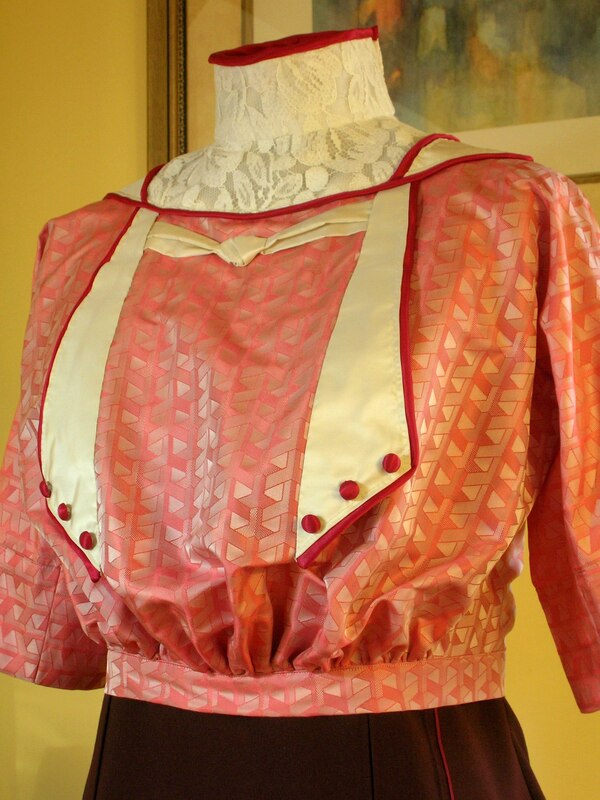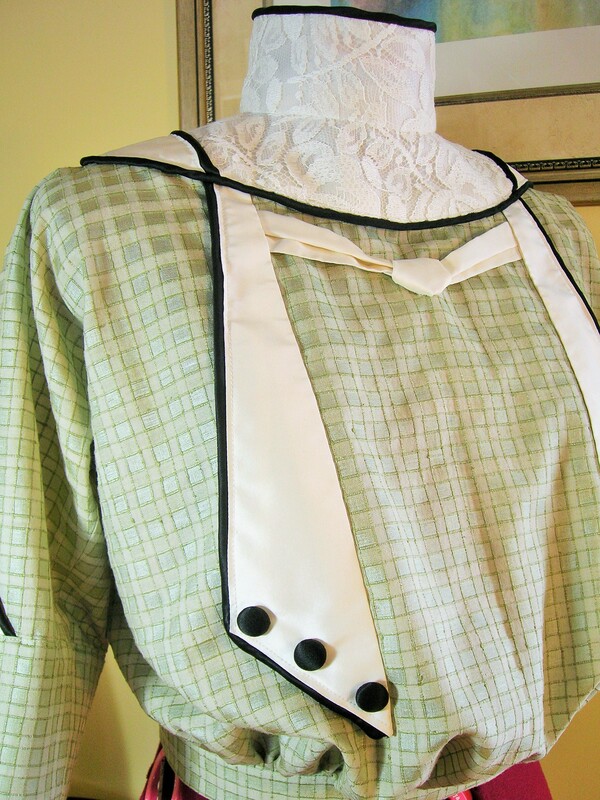|
Except for dresses worn by very elderly women, formal evening wear in the Edwardian and 1910's era always meant a décolletage (low, open neckline). However, there were occasions where a formal appearance was called for, but in a less formal setting. This gown is in that category, appropriate as a visiting, reception, or dinner gown. As an evening gown for dinner, in velvet (as I made the replica) or silk, despite the luxe of the textiles, its high collar would signify informal evening wear -- a gown appropriate for a fancy dinner at home, or with close friends. As a visiting or afternoon gown, it would speak to the highest formality of day wear, whether in velvet or not. This replica was made from silk/rayon velvet in a deep forest green colour, over a full, boned foundation, with hand embroidered insets (plastrons), French cotton guipure lace, and silk satin bias trim. This is a true "Gibson Girl" gown, with a semi-hobble skirt formed by the applied band below the knees. The band can also be omitted, to create a typical trained skirt. The pattern for this afternoon gown is available in my Etsy shop. This design is best suited to those with fairly advanced sewing skills, especially if the gown is made in velvet. Click on this button to go to the Etsy listing: If you're planning to work with velvet and would like some tips and insights into handling this luxury textile, see my blog article here:
0 Comments
Over the years I've created a number of 1910's era blouses, of varying degrees of complexity, some more formal than others. Most of these I've developed into History House sewing patterns graded for 3 or more sizes, available in my Etsy shop (see button link below to jump to those listings). Blouses and shirtwaists of the 1910's were the staple of every woman's wardrobe. Batiste and linen blouses or shirt-waists were everywhere, some with the more formal high, fitted and boned collars, some with the fairly recently acceptable open necklines (especially for warmer weather). These types were most often worn under walking suits, while more dressy silk blouses could stand on their own with a lovely tailored skirt, even as an informal dinner ensemble. Generally the less fancy shirt-waists closed at front, but blouses closed at centre back -- meaning a maid or other helper was necessary to get dressed! The blouses shown here range across the spectrum from rather plain, tailored shirtwaists to the fancier silk blouses. In some cases I made more than one version, usually the initial one as close to the antique colours as possible, and then another on commission in colours specified by the client.
I am still in the process of completing patterns for at least two of these designs -- look for them soon in my Etsy shop! The rest are currently available as sewing patterns (see the pattern cover art included with the images, and use the button link below to access my Etsy shop). This lovely 1912 afternoon gown was commissioned for a special event, to be worn by the actress who had played the Countess of Rothes in the 1997 Titanic movie. The gown was made as a replica of the French original, in the colour (steel blue) and fabric (shantung) described in the antique text. I was originally planning to develop this design as a sewing pattern, but realized after making it that the construction was probably too complex, and that the pattern would really only be feasible for advanced sewists with historical sewing experience. I may still change my mind! As with almost all silk dresses of the era, this one is built over a closely-fitted boned foundation, and with complicated asymmetrical closures. I've included a short video below which I made to demonstrate the closure arrangements on this gown, which were, despite their complexity, not uncommon in dresses of the 1910's. Occasionally I've come across an antique French pattern in my collection that is so interesting or unique that I know I have to re-create it, and this was definitely the case with this wonderful automobile duster (coat) from early 1912, the epitome of fashionable motoring wear of the era. The original design was described as being in black linen with white lace -- a stylish and popular colour combination in 1912, and dramatic with the wide bands of heavy guipure lace. For the initial sample I made from the pattern, I chose a more subdued cocoa-coloured mid weight 100% linen with a fine herringbone weave. The weave created a subtle heathered effect in the finished garment. Although the basic, unlined coat is a relatively straightforward sewing project, the cut and construction is masterful and precise, like most other Edwardian and 1910's designs I've worked with, requiring careful preparation and meticulous sewing. I am always in awe of the technical prowess of the designers of these early 20th century garments and their textile "engineering" abilities, creating garments that follow and enhance the body's form. The deep lace embellishment sections presented a bit of a challenge. My solution was to combine fairly wide guipure lace with narrower lace in bands in an arrangement deep enough to match the original antique design. In total, I used nearly 9 metres of quality wide cotton Cluny lace and over 5 metres of narrower lace to replicate the original lace designs on this coat. I've made two versions of this duster, the first as a sample garment to test my pattern, and the second as a custom project on commission. Both were in medium-weight 100% linen, one the cocoa coloured herringbone weave linen, and the other a plain-woven sand colour. I used extra-large, natural buttons as decorative closures (the actual closures were hidden snaps), on the first Duster the buttons were made of horn, on the second mother-of-pearl. Both Dusters were lovely -- I'm not sure which I liked best. If you'd like to make this Duster for yourself, the pattern is now available in my Etsy shop! Just click on the button below to go directly to the pattern listing.
|
OverviewA photo portfolio, arranged by historical era, of my work in replica antique garments. Click on any category entry below to see contents. Categories
All
Archives
June 2023
|




































































































































 RSS Feed
RSS Feed